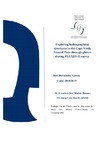Identificador persistente para citar o vincular este elemento:
https://accedacris.ulpgc.es/jspui/handle/10553/57932
| Título: | Exploring hydrographical structures in the Cape Verde Frontal Zone through gliders during FLUXES-II survey | Autores/as: | Hernández García, Inés | Director/a : | Machín Jiménez, Francisco José Coca Saenz De Albéniz, Josep |
Clasificación UNESCO: | 251007 Oceanografía física | Palabras clave: | Cape Verde Frontal Zone Water masses Autonomous Underwater Vehicles (gliders) Remotely Operated Vehicles (SeaSoar) Numerical models, et al. |
Fecha de publicación: | 2019 | Resumen: | The Cape Verde Frontal Zone (CVFZ) is a dynamically complex region located at the eastern North Atlantic Subtropical Gyre (20ºW to 30ºW, ~20ºN), where the warmer and more saline North Atlantic Central Water (NACW) and the colder and less saline South Atlantic Central Water (SACW) interact. It is defined by the intersection of the 36.0 isohaline with the 150 m depth isobath. It is subjected to high variability, with the presence of lateral intrusions, filaments from the upwelling system and mesoscale and submesoscale eddy fields with a sharp thermohaline gradient. Temperature decrease compensates the salinity decrease with depth, so both variables compensate their effect on density, making the front dynamically stable. The aim of this project is to analyse the features at the CVFZ during November 2017 using the in situ FLUXES-II data, obtained from ship CTD stations, a SeaSoar and two deep gliders with biochemical and dynamical instruments. Data and Copernicus Mercator model outputs were compared to determine their skills to capture the mesoscale and submesoscale features. The variables used on this study were potential temperature, practical salinity, potential density and oxygen concentration. Wavelet analyses were conducted to compare the different scales that can be accessed with the sampling methods. It allows to determine the main wavelengths in the signal, using distance as the independent variable rather than time. Results showed that the ship CTD data reaches the greatest depth of all the sampling methods and the SeaSoar is the fastest method. The glider and the SeaSoar capture the smallest scales and show the features with greater detail, while the glider has a slightly better resolution. | Departamento: | Departamento de Física | Facultad: | Facultad de Ciencias del Mar | Titulación: | Máster Universitario en Oceanografía por la Universidad de Cádiz, la Universidad de Las Palmas de Gran Canaria y la Universidad de Vigo | URI: | https://accedacris.ulpgc.es/handle/10553/57932 |
| Colección: | Trabajo final de máster |
En el caso de que no encuentre el documento puede ser debido a que el centro o las/os autoras/es no autorizan su publicación. Si tiene verdadero interés en el contenido del mismo, puede dirigirse al director/a o directores/as del trabajo cuyos datos encontrará más arriba.
Vista completaVisitas
235
actualizado el 06-sep-2025
Descargas
183
actualizado el 06-sep-2025
Google ScholarTM
Verifica
Comparte
Exporta metadatos
Los elementos en ULPGC accedaCRIS están protegidos por derechos de autor con todos los derechos reservados, a menos que se indique lo contrario.
